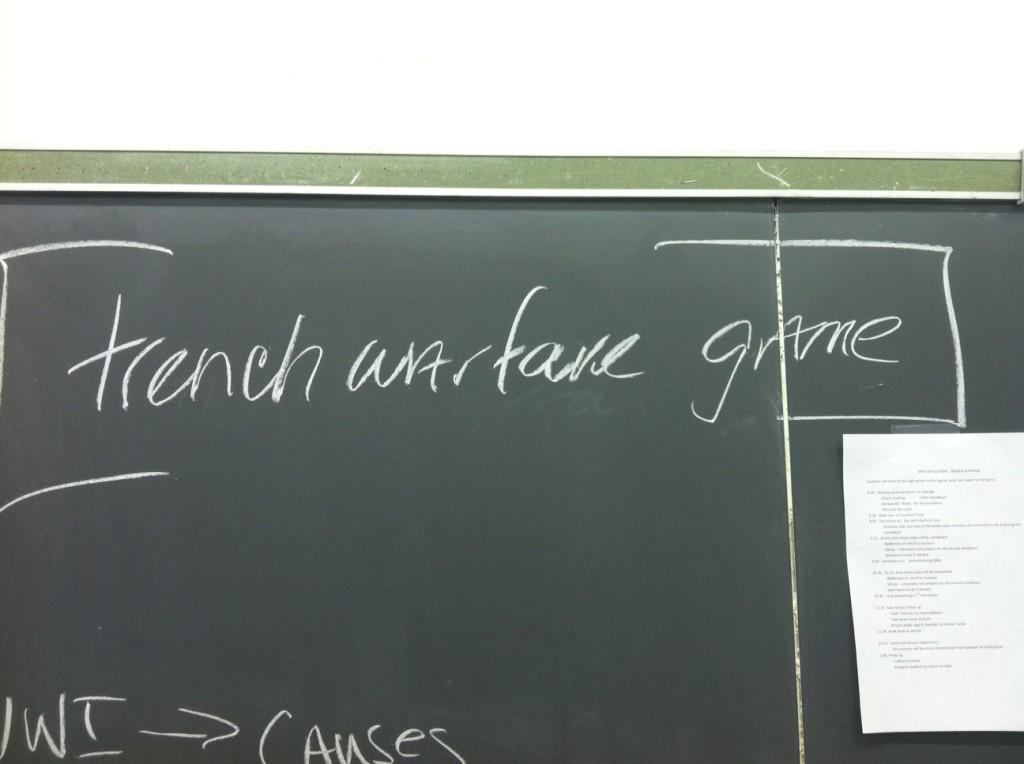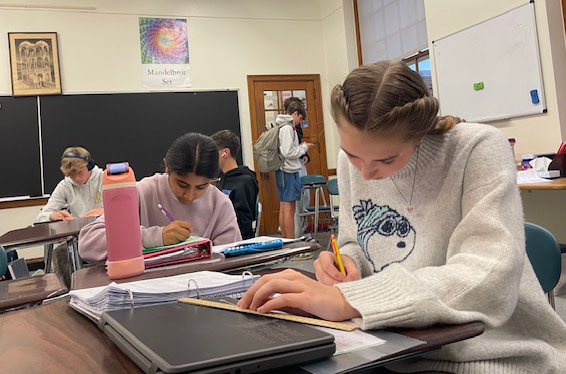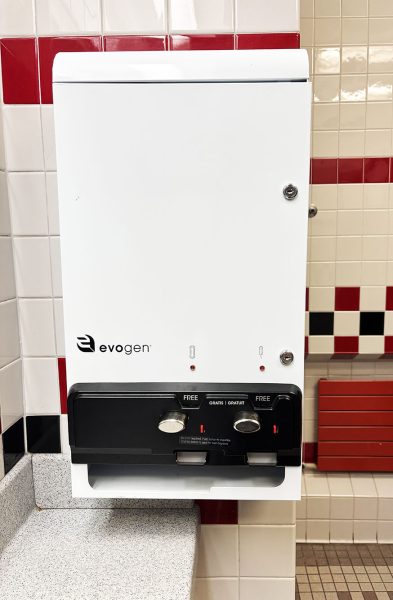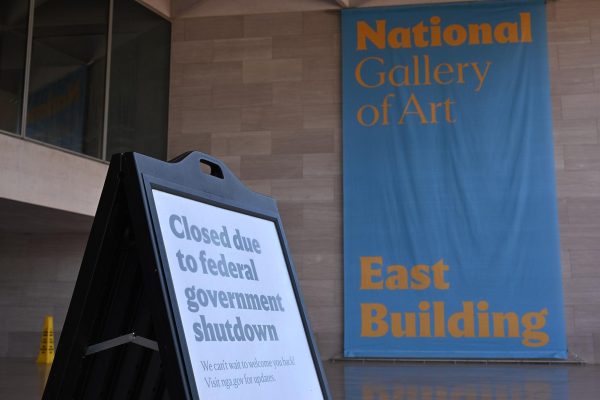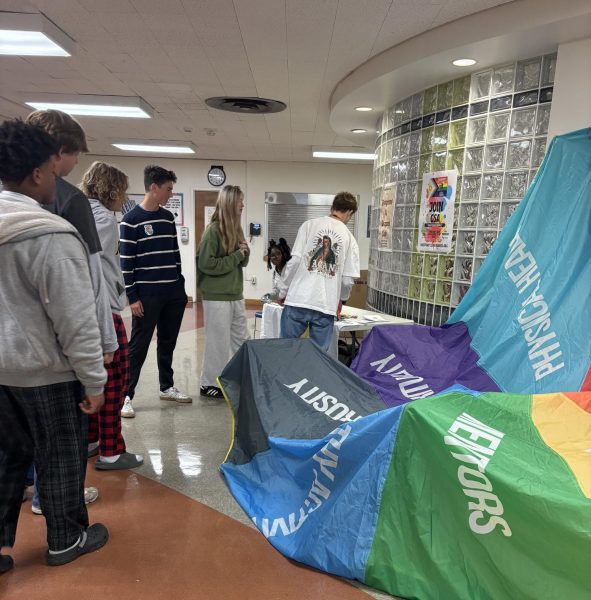Freshmen to Take Battlefield for WWI Simulation
Global studies teachers Paul Kelly, Jessica O’Brien will see a year’s worth of planning in action
The chalkboard in Paul Kelly’s classroom displays a schedule for the reenactment and hints at the competition to come.
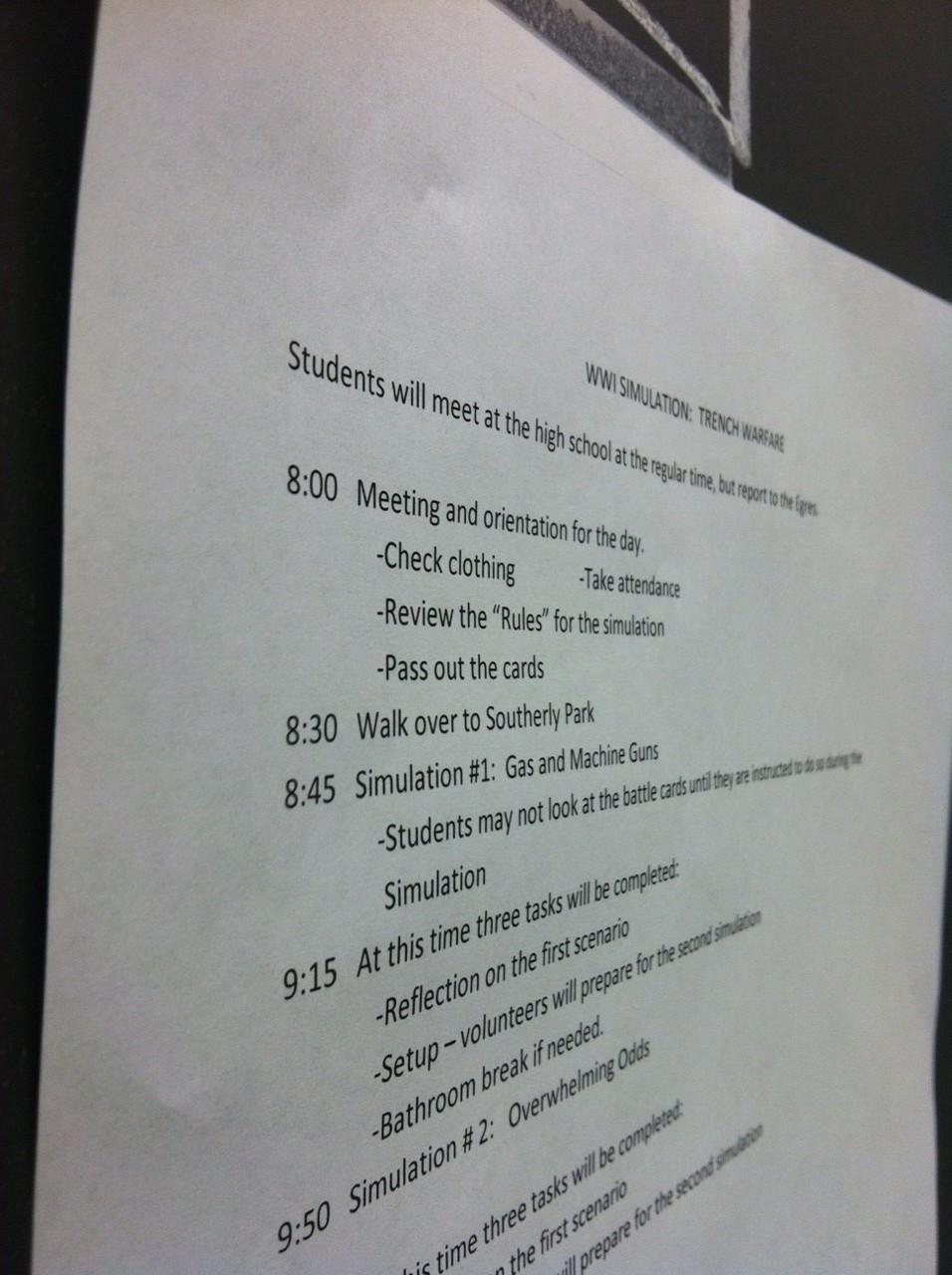 By noon tomorrow, 52 freshmen will have chilly cheeks, numb fingers and a hard-earned appreciation for the challenges of warfare.
By noon tomorrow, 52 freshmen will have chilly cheeks, numb fingers and a hard-earned appreciation for the challenges of warfare.
Global Studies teachers Paul Kelly and Jessica O’Brien will lead their third- and second-period classes to Southerly Park Friday morning. They will perform a World War I trench warfare simulation with help from parent volunteers.
Kelly thinks this activity will do a better job teaching students about the conditions of World War I than traditional approaches.
“We have paint-filled balloons to simulate artillery, and paint-filled land mines. And being outside for four and a half hours in the cold will get the kids to understand how miserable it was for the soldiers,” Kelly said.
One problem the teachers faced was picking which season the event should take place in.
“We talked about picking a day in the spring when it’s not as cold,” said Kelly, “but that wouldn’t give the full effect because the soldiers in World War I didn’t get to pick the weather that they fought in.”
“The colder weather will definitely add to the reenactment,” said Sylvia Sheppard, social studies department chairwoman. “We told the kids to bring a change of clothes and to make sure they’re dressed appropriately for the weather.”
Tomorrow’s forecast predicts a sunny 21 degrees and west by southwest winds of 11 mph at 8 a.m. By noon, the temperature is predicted to reach 26 degrees.
“At the end of the day you can never really re-create war,” said Kelly, “but I think this is a step closer than just reading about it in the textbook.”
According to O’Brien, the idea for the exercise came from a school in California. In fact, schools in Texas, North Carolina and England have also conducted World War I simulations with students. O’Brien said she and Kelly have been preparing for tomorrow’s event for months.
“I sat in a lot of meetings with Mr. Kelly, Ms. O’Brien, and Mr. Griffith this summer,”said Sheppard, who gave departmental approval for the in-school field trip. “They had a plan, and we’ve been working out the kinks over the past year.”
Sheppard thinks it will be a great alternative to just reading about WWI in a textbook.
“It’s more kinesthetic and really engages all the students,” she said.
Freshman Amelia-Bayless Marr, who will participate in the activity, described the simulation as “basically going out to a field, in the snow, hiding in makeshift trenches, and throwing paint balls or something at each other.”
While one Amarillo, Texas school’s simulation last month included students escaping mock machine gun fire, Shaker freshmen will not encounter any realistic weapons. “Water balloons are gonna be filled with paint,” said freshman Caroline Kruithoff. “They will represent grenades. The ropes are representing barbed wire.”
According to Kelly, only parents will lob balloons at students. Parents will also provide medical attention to “wounded” soldiers. “We have a lot of parent volunteers,” O’Brien said.
“There will be two side medics running in to help people, and you get three chances to die. After the third chance you have to lay there,” said freshman Margaret Cook.
The schedule calls for two distinct simulations. The first is titled Gas and Machine Guns. The second, Overwhelming Odds. If time allows, a third simulation will be enacted. Restroom breaks are slated for 9:15 a.m. and 10:30 a.m.
Sheppard also said the event could be a great addition to the Global Studies curriculum.
“I would absolutely have my classes participate in the future,” Sheppard said. “I think kids remember activities that they have fun doing and activities that will stick with them, and I think this is definitely something that would stick with them.”
Bayless-Marr is apprehensive about the wintry conditions. “I’ll have to wear, like, five layers!”
Kelly predicted that event may grow and become a useful exercise for all subjects. “You could turn it into some kind of IB activity by having subjects like math,chemistry, biology and English involved as well as history,” he said.
“You could measure the trajectory of artillery shells, learn about the mustard gas, and write journals or essays about the experience,” said Kelly. “There are a lot of possibilities, and it could really be a great experience for all the Global Studies classes.”
Freshman Claire Connors, whose class is not among those participating, is not disappointed, however. “I didn’t really want to spend five hours out in the snow,” she said.
Alana Williams, Joslyn Laster, Anabel McGuan, Nora Spadoni, Dennis Cavin, Zoe Ivory, Audie Lorenzo and Samuel Bistritz contributed reporting.

